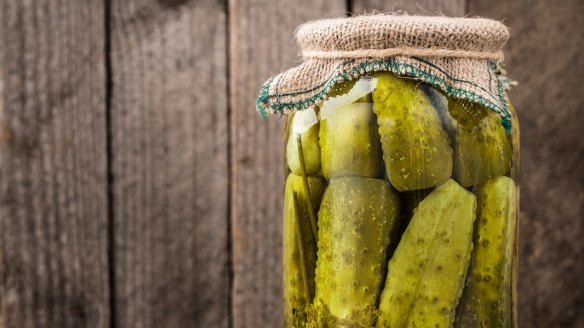Why you shouldn't reuse pickling vinegar to make another batch

Can I use the vinegar from my pickled cucumbers for another batch? R. O'Shea
One of summer's great joys is picking the first zucchinis of the season from the garden and pulling out Stephanie Alexander's Cook's Companion and flicking through to find her turmeric-rich recipe for pickled zucchini. I have had one jar in the cupboard for several years, allowing the mustard seed and turmeric flavours to settle and mellow. That a jar of food can last so long without going off is due to the acid in the vinegar. Bacteria, such as those that cause botulism poisoning, cannot survive when the pH drops below 4.5. The lower the pH, the more acidic the sample you're testing. Water has a pH of 7, black coffee 5 and tomato juice 3.5. But you also want to stop the pickles from fermenting. Natural fermentation from the lactobacillus present on plants turn sugars into lactic acid. They keep producing lactic acid (making the environment inhospitable to bad bugs) until the pH drops to about 4 or 3.5. So you need to have quite an acidic solution to stop the pickles fermenting. This is why you use vinegar, which has a pH of about 2.5-2. However, as the cucumbers sit in the vinegar solution, they release water, diluting the vinegar and raising its pH. So it is not a good idea to re-use the vinegar as you may bring about fermentation in the ensuing batch. Once you've eaten all the pickles, you could use the remaining vinegar to start a mayonnaise, brine a chicken, flavour a potato salad or liven up a dip. Another idea would be to use salt and naturally occurring lactobacillus to make really tasty pickles with a lovely lactic tang and a softer, smoother finish than vinegar pickles.
How can I reduce the amount of butter in a cake recipe? P. Ferguson
Butter is 85 per cent fat and makes a cake tender by coating the proteins in the flour, glutenin and gliadin, preventing them from combining and forming the elastic protein called gluten. To form gluten, these proteins need water to hydrate. If they are coated in fat, this hydration is disrupted. The result is a softer, denser crumb. Sugar also stops the formation of gluten by binding with the water, making it unavailable to the proteins. Many low-fat products have loads of sugar to make them moist and tender. A healthier way of reducing fat in a cake is to substitute one-third of the butter or margarine for the same volume of concentrated fruit puree, such as well-cooked apple or pear. Add the cooled puree after the fat has creamed with the sugar.
Letters
Recently we were discussing finding substitutes for celery, as some people do not like the taste. Several people wrote in suggesting using water chestnuts, available tinned, to replace celery's crisp crunch. One reader, J. Laurie, wrote, "My partner doesn't like celery, but I do. So I found a way around it: slice the celery and marinate it overnight in white wine, lemon juice, mint, salt, and pepper with sweet chilli sauce. Then drain and just add it into whatever you're cooking or scorch it for a minute in a hot frypan, allow it to cool, and add it to a salad. It is still celery, but nutty and sweet."
Send your vexing culinary conundrums to brainfood@richardcornish.com.au or tweet to @foodcornish.
Appears in these collections
- More:
- Food
- Brain food
